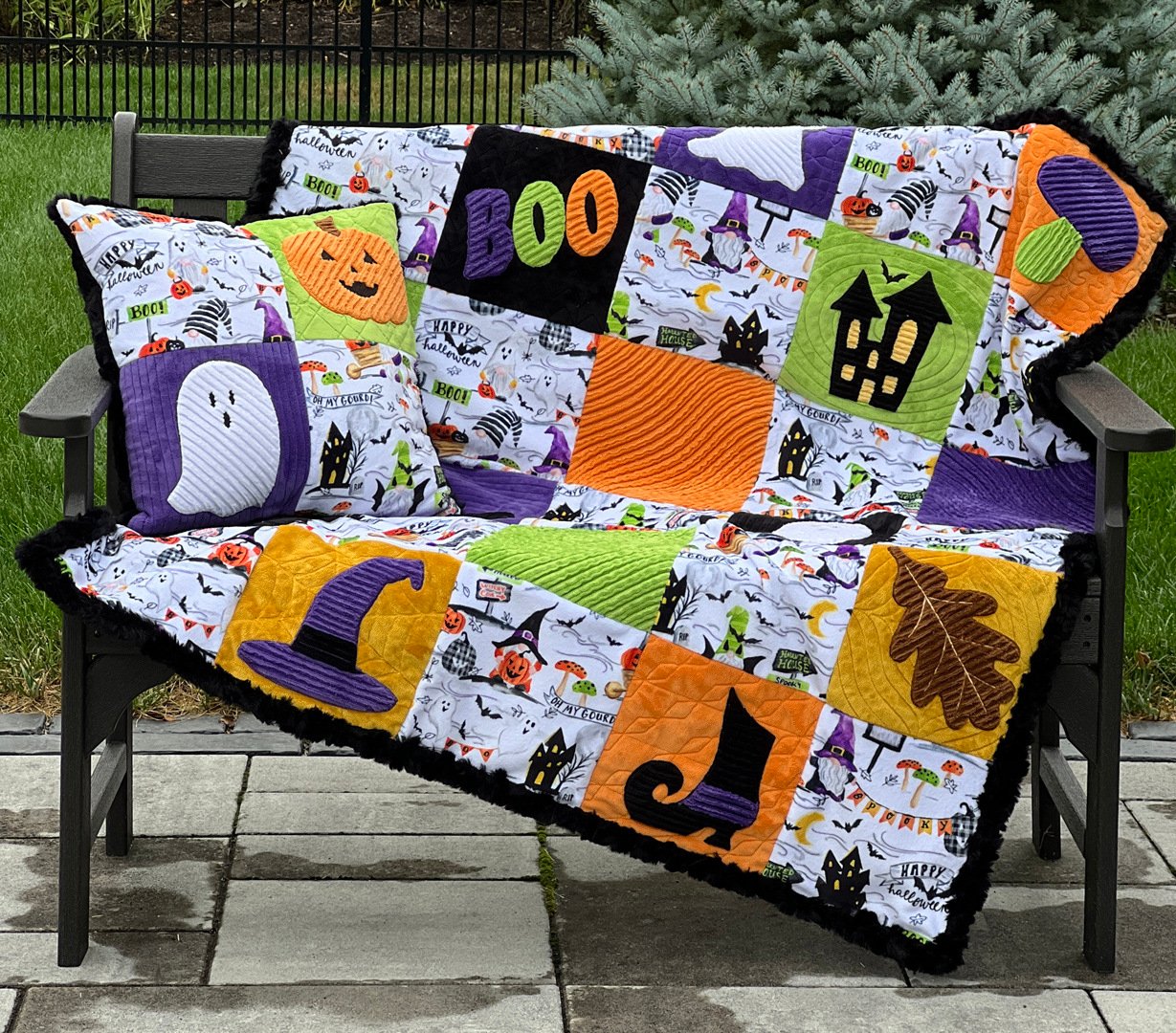Written by Cuddle® Ambassador Reen Wilcoxson, Embroidery Garden https://www.embroiderygarden.com/
Spooky season is one of the most fun times of year for quilters and sewists. It's when you can let your creativity run loose and create all sorts of fun Halloween sewing projects! We were inspired by this project, created by Cuddle® Ambassador Reen Wilcoxson of Embroidery Garden. She utilizes a unique new technique that gives your Cuddle® an incredible, intricate new texture.
How to Make a Halloween Cuddle® Chenille Quilt and Pillow Set
This spooktacular quilt full of texture, rich colors and incredible softness is perfect for snuggling under during the chilly days of October while waiting for Halloween to arrive...or, for Halloween night, waiting for trick or treaters to visit your doorstep! The chenille technique adds a fun mix of texture and dimension.

What is Needed for the Chenille-Cuddle® Technique
The quilt was made using Cuddle® 3 for the blocks and a Luxe Cuddle® for the backing and binding. There are 15 printed blocks, 5 solid chenille blocks and 10 chenille blocks with Halloween related designs on them in the quilt. Chenille is created using layers of fabric that are stitched together with lines that are spaced up to ½” apart. The layers are cut between the sewn channels and the fabric ‘blooms’ to create texture and depth.

The blocks, except for the digitally printed blocks, were stitched using a chenille technique and Cuddle® 3 on an embroidery machine. The beautiful, finished appearance is created with 1 base layer and 2 additional layers placed on top.
Creating the Machine Embroidery Designs
The machine embroidery designs for the blocks were created using a feature in Designs In Machine Embroidery’s new Special FX software. With just a few clicks the chenille effect can easily be applied to included artwork or artwork you bring into the software.

Chenille can also be made using a sewing machine and stitching channels spaced about ½” apart.
Tools/Sewing Notions Needed
- ‘Oh My Gourd’ digital Cuddle® print from Shannon Fabrics.
- A selection of 5 coordinating solid Cuddle® 3 fabrics.
- Matching Luxe Cuddle® for the back and binding.
- An embroidery machine with a 9.5x9.5 hoop
- SF101 - This is a lightweight fusible interfacing that was ironed to the backside of the Cuddle® print blocks only. This helped to control the stretch while sewing.
- Polyester embroidery thread and a 75/11 needle for embroidery.
- 80/12 stretch needle for sewing the blocks together
- Quilter’s Select Dream Polyester Batting for the machine embroidered blocks only.
- A plastic film topper made for machine embroidery. This will keep the embroidery stitches from sinking into the pile and aid in creating the chenille.
- A chenille cutter - pictured here, Slash Cutter by Clover
- Inexpensive muslin for the machine embroidered blocks. I chose not to use stabilizer. If you want to use stabilizer, use cutaway no show.

Creating the Pieces
Cut (15) print blocks 9.50” x 9.50” backing them with SF101, (3) 11”x 11” squares of solid Cuddle® 3 from each of the 5 solids and (10) 11” x 11” blocks (2 out of each solid color) for the base of the blocks with designs. (15) pieces of batting were cut 11” x 11”. The batting is used on all blocks except for the printed blocks.
The Halloween designs use smaller pieces of assorted colors, and the size of those pieces are determined as the blocks are stitched.
Hoop a piece of muslin or cutaway stabilizer. Stitch the placement line for the first chenille square. Center batting over this placement and 1 piece of Cuddle® over the batting. Make sure the nap is going downward, and the stretch is going across the hoop. Cuddle® likes to move around. Pin fabrics in place keeping them out of the stitch line during the embroidery steps.

Place the 2 remaining pieces of matching Cuddle® on top of the first piece. Check the direction of the nap and stretch and pin in place.


Once the channels have stitched, remove the hoop from the machine. Using a chenille cutter, cut down the center of each channel. Note you are only cutting the top 2 layers. The base layer is not cut.

After cutting the channels, use your fingernails to ‘rough’ up the edges. This will create Cuddle® dust. Having a small vacuum nearby will quickly clean up the block and surrounding area.

Cover the entire block with the topper pinning it in place. A final outline will stitch around the block. The topper keeps the cut ends from tangling around the foot of the machine.

Remove the block from the hoop. Trim ¼” past the stitching all around. You may want to shake the block or use the vacuum again to tidy up.
Isn’t the texture amazing?


To stitch a block with a design, the steps are similar. Stitch the placement line and put down the batting and 1 piece of Cuddle® 3 for the background and stitch it in place. Any background quilting should stitch next.
For blocks with designs, each section that has chenille in it has 4 steps – a placement, a tack down, stitching the channels and a final outline.
After the quilting the machine will stitch a placement for the design. Cut a piece of Cuddle@ larger than the placement. Be generous with the cut and let the machine stitch it in place.


Place 2 more layers of Cuddle® down and stitch the channels.
Cut the channels, fluff up and cover with the topper. The next step stitches the final outline of that section. Trim close to the stitching through all 3 layers of Cuddle®.
If the design has another section, repeat the above steps.
If the design has no other stitching, remove the block from the machine and trim as above. Some designs may have additional stitching, like the eyes on the ghost, the bats around the haunted house, etc. Keep the topper on and finish the design.

Assembling the Quilt Blocks
Once all blocks are finished and trimmed, lay them out in rows in a pattern that pleases you. Sew the blocks into rows then sew the rows together. To make it more manageable, stitch the top 3 rows together, then the bottom 3 rows together. Finally stitch those 2 sections together. Using a walking foot helps keep the layers from slipping. You will also want to slightly increase your stitch length and use a 90/14 or 80/12 stretch needle when sewing Cuddle®.
Cut the backing from Luxe Cuddle® to the size of the top and place right side down. Place the finished top right side up matching all edges. Use lots of pins or clips to keep the 2 pieces together. Baste close to the edge all around to keep the front and back together.
Binding strips were cut from Luxe Cuddle® at 1.75” wide and stitched to the back side. The edge was brought to the front and stitched down using a wide, loose zigzag or a serpentine stitch.
Using Cuddle® for your chenille projects opens a new world of possibilities. You can stitch beautiful designs that are a delight and appeal to everyone.
Whether you use chenille and Cuddle® in a quilt, pillow or wearable item, whoever sees and feels it will fall in love with your creation.
You can follow Embroidery Garden on Facebook and Instagram: @embroiderygarden to see more projects stitched using Cuddle® fabrics.

%20-%20Copy%20copy.png?width=143&height=69&name=Black%20logo%20(002)%20-%20Copy%20copy.png)









-Dec-11-2025-10-58-46-1415-PM.png?width=640&name=Untitled%20design%20(3)-Dec-11-2025-10-58-46-1415-PM.png)






.png?width=640&name=SEW%20TOGETHER%20livestream%20promo%20images%20(4).png)
.jpg?width=640&name=gencoreA%20(1).jpg)
-Oct-06-2025-07-25-25-9749-PM.png?width=640&name=SEW%20TOGETHER%20livestream%20promo%20images%20(1)-Oct-06-2025-07-25-25-9749-PM.png)

-4.png?width=640&name=SEW%20TOGETHER%20livestream%20promo%20images%20(3)-4.png)





.jpg?width=640&name=spring%20tea%20party_049%20(1).jpg)





.png?width=640&name=12%20Days%20of%20Cuddle%C2%AE%20(8).png)
.png?width=640&name=12%20Days%20of%20Cuddle%C2%AE%20(3).png)
-2.png?width=640&name=12%20Days%20of%20Cuddle%C2%AE%20(2)-2.png)

-2.png?width=640&name=12%20Days%20of%20Cuddle%C2%AE%20(4)-2.png)
.png?width=640&name=12%20Days%20of%20Cuddle%C2%AE%20(7).png)
.png?width=640&name=12%20Days%20of%20Cuddle%C2%AE%20(2).png)
.png?width=640&name=12%20Days%20of%20Cuddle%C2%AE%20(6).png)


















Leave a Comment